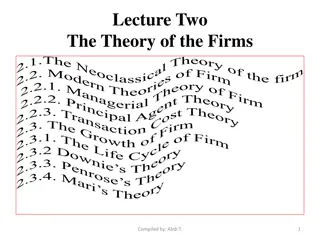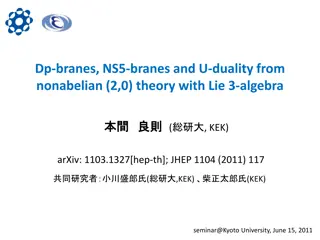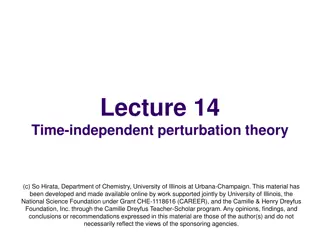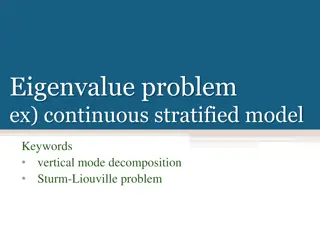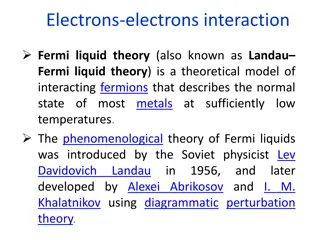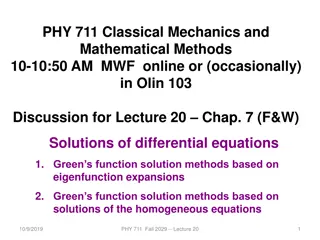
Theory Notes on Sturm-Liouville Equations and Operators
Explore insightful notes on Sturm-Liouville theory applied to second-order differential equations, matrices, and more, with discussions on self-adjoint forms, inner product definitions, and related concepts in mathematics.
Download Presentation

Please find below an Image/Link to download the presentation.
The content on the website is provided AS IS for your information and personal use only. It may not be sold, licensed, or shared on other websites without obtaining consent from the author. If you encounter any issues during the download, it is possible that the publisher has removed the file from their server.
You are allowed to download the files provided on this website for personal or commercial use, subject to the condition that they are used lawfully. All files are the property of their respective owners.
The content on the website is provided AS IS for your information and personal use only. It may not be sold, licensed, or shared on other websites without obtaining consent from the author.
E N D
Presentation Transcript
= L u u ECE 6382 Fall 2023 David R. Jackson Notes 18 Sturm-Liouville Theory Notes are from D. R. Wilton, Dept. of ECE 1
Sturm-Liouville Theory We first illustrate Sturm-Liouville theory for solutions to second- order differential equations. We then apply the theory to matrices (linear algebra). Jacques Charles Fran ois Sturm Joseph Liouville 2
Second-Order Linear Differential Equations (SOLDE) A SOLDE has the form 2 d y dx dy d + y + = ( ) ( ) ( ) ( ) f x p x p x p x y 0 1 2 2 x = If , the equation is said to be "homogeneous". ( ) x 0 f The inhomogeneous equation can be solved once we know the solution to the homogeneo us equation using the method of Green's functions (discussed later). Boundary conditions (BC) are usually of the form = = ( ) ( ) y a ( ) y b y b = 0 ( = ) y a Dirichlet ( ) 0 ( Neumann) 3
Sturm-Liouville Form If we multiply the general differential equation + y + = ( ) ( ) ( ) ( ) f x p x y p x y p x y 0 1 2 ( ) ( ) t p p t x 1 d t e 0 = by the integrating factor we have: ( ) x w ( ) x p 0 ( ) ( ) t ( ) ( ) t p p t p p t x x 1 1 ( ) ( p x p x dt dt y + = ( ) ( x ) ( ) ( ) w x f x e y e y p w x y 1 0 0 2 ) 0 ( ) ( ) t p p t x 1 d dx dt + = ( ) ( ) p x w x y ( ) ( ) w x f x e y 0 2 Dividing this result by yields ( ) w x 1 ( ) ( ) dx d dy x + = ( ) ( ) ( ) Q x y x ( ) f x P x w x dx ( ) ( ) t p p t x 1 dt where ( ) , ( ) ( ) P x e Q x p x 0 2 4
Sturm-Liouville Operator This is called the Sturm-Liouville or self-adjoint form of the differential equation: 1 ( ) ( ) dx d dy x + = ( ) ( ) ( ) Q x y x ( ) f x P x w x dx or (using u instead of y): = Ly u f Where is the (self-adjoint*) Sturm-Liouville operator: * Discussed later 1 ( ) d d dx + L= ( ) ( ) P x Q x w x dx Note: The operator is assumed to be real here (w, P, Q are real). The solution u does not have to be real (because f is allowed to be complex). 5
Inner Product Definition An inner product between two functions is defined: We define an inner product as b * , ( ) u x v x ( ) ( ) u v w x dx a where is called a weight function. ( ) x w Although the weight function is arbitrary, we will choose it to be the same as the integrating function This will give us the nice "self -adjoint" properties, as we will see. in the Sturm-Liouville equation. ( ) x w 6
The Adjoint Problem The adjoint operator is defined from = L , , u v u v L = L , , L u v u v = For the Sturm-Liouville operator so L L. . (proof given next) Hence, the Sturm-Liouville operator is said to be self-adjoint: 1 ( ) d d dx = = + L= L ( ) ( ) P x Q x w x dx Note: Self-adjoint operators have nice properties for eigenvalue problems, which is discussed a little later. 7
Proof of Self-Adjoint Property Consider the inner product between the two functions and L : u v b b = * Recall: * , ( ) u x v x w x dx ( ) ( ) u v L , ( ) ( ) v x w x L ( ) u x dx u v a a = b 1 d d dx ( ) + * ( ) ( ) ( ) ( ) u x dx v x w x P x Q x ( ) w x dx a b d dx d dx ( ) = + * ( ) ( ) ( ) ( ) u x dx v x P x Q x w x a The first term i nside the square brackets is first integrated by parts, twice: b b b * ( ) dx ( ) dx ( ) dx ( ) dx d dx du x du x du x dv x = + * * ( ) ( ) ( ) ( ) v x P x ( ) v x P x dx P x dx a a a b b * ( ) dx ( ) dx ( ) du x dv x du xdx dx = + a * ( ) ( ) v x P x ( ) P x a b b * * ( ) dx ( ) dx ( ) dx du x dv x d dx dv x = + * ( ) ( ) v x P x ( ) ( ) u x ( ) u x ( ) P x P x dx a a 8
Proof of Self-Adjoint Property (cont.) Hence, we have: b b * * ( ) dx ( ) dx ( ) dx du x dv x d dx dv x = + * L , ( ) ( ) v x P x ( ) ( ) u x ( ) u x ( ) u v P x P x dx a a b ( ) + * ( ) ( ) ( ) v x Q x u x w x dx a Multiply and divide by w(x), combine with last term. or b * ( ) dx ( ) dx du x dv x = + * L , ( ) ( ) v x P x ( ) ( ) u x u v P x a b 1 ( ) d d dx + + * ( ) ( ) u x w x ( ) ( ) ( ) P x Q x v x dx w x dx a 9
Proof of Self-Adjoint Property (cont.) b * ( ) dx ( ) dx du x dv x = + * L , ( ) ( ) v x P x ( ) ( ) u v P x u x a b 1 ( ) d d dx + + * ( ) u x ( ) ( ) x ( ) ( ) P x Q v x w x d x w x dx a This can thus be written as: Note: b = + L , ( , ) J u v , L u v u v ( ) * v = = real operator * L Ly v a ( ) L where * ( ) dx ( ) dx du x dv x + * ( , ) J u v ( ) ( ) ( ) u x P x v x = = = ( ) ( ) y a ( ) ( ) y b 0 ( 0 ( = ) y a y b Dirichlet b From boundary conditions we have: = ( , ) J u v 0 a Neumann) b ( ) = * L , L , L u v u v = ( ) u x ( ) v x ( ) w x dx (proof complete) a 10
Eigenvalue Problems We often encounter an eigenvalue problem of the form = L u u (The operator can be the Sturm-Liouville operator, or any other operator here.) The eigenvalue problem (with boundary conditions) is usually only satisfied for specific eigenvalues: ( ) u a u a = = ( ) ( ) u b 0 ( 0 ( = ) u b = Dirichlet = = , 1,2, n n ( ) Neumann) For each distinct eigenvalue, there corresponds an eigenfunction u = un that satisfies the eigenvalue equation. 11
Property of Eigenvalues Property 1 The eigenvalues corresponding to a self-adjoint operator are real. Proof: = L u u = L u u b b ( ) = * * L u u wdx uu wdx ( ) * = * * u L u a a b b = L , , u u u u ( ) * = * * L u uwdx u uwdx = , L , u u u u a a = * , L , u u u u = , L , u u u u = * Hence: (proof complete) 12
Orthogonality of Eigenfunctions Property 2 The eigenfunctions corresponding to a self-adjoint operator equation are orthogonal*if the eigenvalues are distinct. *Orthogonal means that the inner product is zero. Consider two different solutions of the eigenvalue problem corresponding to distinct eigenvalues: = L u u = L u u m m m n n n n m b b b b ( ) * = * n * L = u u wdx m n u u wdx * n * n L u u wdx u u wdx m m n m m a a a a Subtract ) ( b b ( ) ( ) ( ) * = * n * n * L L u u u u wdx m n u u wdx m m n m a a 13
Orthogonality of Eigenfunctions (cont.) The LHS is: ) ( b ( ) ( ) * = * n L L L , , L u u u u wdx u u u u m m n m n m n a = , L , L ( ) u u u u from the definition of adjoint m n m n = , L , L ( ) u u u u from the self - adjoint property m n m n = 0 Hence, for the RHS we have b b ( ) ( ) = = * n * * 0 0 m n u u wdx m n u u wdx orthogonality m a a = * n since , n m n (proof complete) 14
Summary of Eigenvalue Properties Assume an eigenvalue problem with a self-adjoint operator: = = L , L L u u = L , , u v u v L Then we have: The eigenvalues are real. The eigenfunctions corresponding to distinct eigenvalues are orthogonal. That is, = * m a) m b = = * n , 0, u u u u wdx b) m n m m n a 15
Example Orthogonality of Bessel functions Derive this identity: 1 ( ) ( ) = 0, J p x J p x xdx m n m n 0 ( ) x = th p m J root of m ( ) x = th p n J root of n 16
Example (cont.) Recall: b ( ) x u ( ) ( ) x w x dx = * n 0 ( u for a Sturm-Liouville problem) m a ( ) a ( ) b = = if 0 ( ) u u Dirchlet boundary conditions , , m n m n ( ) x ( ) ( ) x ( ) = = , Consider: u J p x u J p x m v m n v n = = 0, 1 a b Choose: ( ) ( ) ( ) = = = 0 0, 1 0 , J p J p i m n i i = (The first equation is true for . The case can be considered as a limiting case.) 0 0 1 ( ) ( ) ( ) = 0, J p x J p x w x dx m n What is w(x)? m vn 0 (This will be true if if um and un correspond to a Sturm-Liouville eigenvalue problem.) 17
Example (cont.) 1 ( ) x u ( ) ( ) x w x dx = 0, u m n m n 0 ( ) ( ) x ( ) ( ) x ( ) = = , u J p x u J p x m v m n v n This orthogonality will be true if if um and un correspond to a Sturm- Liouville eigenvalue problem, with the associated function w(x). What is w(x)? We need to identify the appropriate Sturm-Liouville eigenvalue problem that u(x) satisfies: 1 ( ( ) dx d dx du x + = ( ) ( ) ( ) Q x u x P x u ) w x 18
Example (cont.) ( ) ( ) ( ) t + + = = 2 2 2 Bessel equation: 0, t y ty t y y t J Use: = = , t p x dt p dx i i 1 p ( ) ( ) u x = y t is then denoted as t x i ( ) ( ) u x ( ) ( ) = = = , 1,2 u x J p x i i i Note: ( ) + + = 2 2 2 2 0 The primes now mean differentiating with respect to x. x u xu p x u i 2 1 x + + = 2 0 u u p u i 2 x 19
Example (cont.) Rearrange to put into Sturm-Liouville eigenvalue form: 2 1 x + + = 2 0 u u p u i 2 x 2 1 x + = 2 u u u p u i 2 x 2 1 x ( ) u x ( ) + = 2 , , u u u u J p x p i i 2 x 2 1 d x dx d dx + = x u u 2 x 20
Example (cont.) Hence, we have: 2 1 x dx d d dx ( ) + = 2 , , x u u u J p x p i i 2 x Compare with our standard Sturm-Liouville eigenvalue form: 1 ( ) d d dx + = ( ) ( ) P x Q x u u w x dx We can now see that the u(x) functions come from a Sturm-Liouville problem, and we can identify: 2 ( ) x ( ) ( ) = = = , , w x P x x Q x 2 x 21
Example (cont.) Hence, we have: b ( ) x u ( ) ( ) x w x dx = * n 0 u m a 1 ( ) ( ) = 0, J p x J p x xdx m n m n 0 ( ) ( ) = = th 0 J p w he r e root of Bessel funct ion p i J i i 22
Adjoint in Linear Algebra An inner product between two vectors is defined as: = * * , a b a b ab (There is no weight function here.) i i i An adjoint of a square complex matrix [A] is defined from: = , , Au v u A v Self-adjoint means: = A A 23
Adjoint in Linear Algebra (cont.) Theorem For a complex square matrix [A], the adjoint is given by = * t i.e., the conjugate of the transpose) ( A A * H t the Hermetian transpose) Note: ( A A P ro o f : To show this, w e need to show: = * t , , Au v u A v = a b = * * where , a b ab i i i To sh ow this: ( ) = = * i * , Au v A u v u A v ij j j ij i i j i j ( ) ( ) = = = * * j * j * t t , u A v u A v u A v u A v relabeling and i j i ij i ji j ij i i j i j i j 24
Adjoint in Linear Algebra (cont.) For a complex matrix we have established that = * t A A Therefore, if a complex matrix is self-adjoint, this means that: A = = * t H A A (The matrix is then also called Hermetian.) Note: For a real matrix, self-adjoint means that the matrix is symmetric. 25
Orthogonality in Linear Algebra Because a Hermetian matrix is self-adjoint, we have the following properties: The eigenvalues of a Hermetian matrix are real. The eigenvectors of a Hermetian matrix corresponding to distinct eigenvalues are orthogonal. The eigenvectors of a Hermetian matrix corresponding to the same eigenvalue can be chosen to be orthogonal (proof omitted). For a real matrix, these properties apply to a symmetric matrix. 26
Diagonalizing a Matrix If the eigenvectors of an N N matrix [A] are linearly independent, the matrix can be diagonalized as follows: A e D = 1 e (proof on next slide) 0 0 0 0 0 0 e e e e e e e e e e e e 11 12 1 1 N 0 0 0 e 1 2 e e D 21 22 2 2 N = = = e N 0 0 31 32 3 N 0 41 42 4 N N e e 1 n e 2 n = = th n eigenvector (a column vector) corresponding to eigenvalue n n e Nn 27
Diagonalizing a Matrix (cont.) Proof of diagonalization property: e D e e ( ) = e from properties of a diagonal matrix 1 1 2 2 N N A e e e ( ) = e from properties of eigenvectors 1 1 2 2 N N (Please see next slide.) Hence, we have A e = e D so that Note: A e D e = 1 The inverse will exist since the columns of the matrix [e] are linearly independent, by assumption. 28
Diagonalizing a Matrix (cont.) e D e e ( ) = e from properties of a diagonal matrix 1 1 2 2 N N 0 0 0 0 0 0 e e e e e e e e e e e e e e e e 1 11 e e e e 2 12 e e e e 3 13 e e e e 3 14 e e e e 11 12 13 14 1 1 21 2 22 3 23 3 24 0 0 0 e D e e 21 22 23 24 2 = = = e 4e 1 1 2 2 2 2 4 0 0 31 32 33 34 1 31 2 32 3 33 3 34 3 0 41 42 43 44 1 41 2 42 3 43 3 44 4 A e e e ( ) = e from properties of eigenvectors 1 1 2 2 N N A A A A A A A A A A A A A A A A e e e e e e e e e e e e e e e e 11 12 13 14 11 12 13 14 A e A e A e A e e e e e 21 22 23 24 21 22 23 24 = = = A e 1 2 3 4 4 1 1 2 2 3 3 4 4 31 32 33 34 31 32 33 34 41 42 43 44 41 42 43 44 Note: We visualize here for a 4 4 matrix. 29
Diagonalizing a Matrix (cont.) If the matrix [A] is Hermetian (self-adjoint), then the eigenvectors are orthogonal, and hence linearly independent. We then have A e D e = 1 A Hermetian matrix is always diagonalizable! If the eigenvectors are scaled so that they have unit magnitude, then we also have: M e ( I ) = * t e identitymatrix This follows from the orthogonality property of the eigenvectors: ( 0 m n mn M e e m ) = = * n ( ) th * m . m M e The row of is the transpose of Note: For the diagonal elements, [M]mm = 1 if the eigenvectors have been scaled so that * m m e e = 1 30
Diagonalizing a Matrix (cont.) Hence, for a Hermetian matrix with scaled (unit-magnitude) eigenvectors we then have: e ( ) 1 = * t e the eigenvalue matrix is "unitary" Therefore, for a Hermetian (self-adjoint) matrix with scaled (unit-magnitude) eigenvectors we have: A = e * t e D 31




